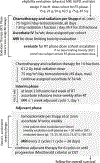First-in-Human Phase I Clinical Trial of Pharmacologic Ascorbate Combined with Radiation and Temozolomide for Newly Diagnosed Glioblastoma
- PMID: 31427282
- PMCID: PMC6858950
- DOI: 10.1158/1078-0432.CCR-19-0594
First-in-Human Phase I Clinical Trial of Pharmacologic Ascorbate Combined with Radiation and Temozolomide for Newly Diagnosed Glioblastoma
Abstract
Purpose: Standard treatment for glioblastoma (GBM) includes surgery, radiation therapy (RT), and temozolomide (TMZ), yielding a median overall survival (OS) of approximately 14 months. Preclinical models suggest that pharmacologic ascorbate (P-AscH-) enhances RT/TMZ antitumor effect in GBM. We evaluated the safety of adding P-AscH- to standard RT/TMZ therapy.
Patients and methods: This first-in-human trial was divided into an RT phase (concurrent RT/TMZ/P-AscH-) and an adjuvant (ADJ) phase (post RT/TMZ/P-AscH- phase). Eight P-AscH- dose cohorts were evaluated in the RT phase until targeted plasma ascorbate levels were achieved (≥20 mmol/L). In the ADJ phase, P-AscH- doses were escalated in each subject at each cycle until plasma concentrations were ≥20 mmol/L. P-AscH- was infused 3 times weekly during the RT phase and 2 times weekly during the ADJ phase continuing for six cycles or until disease progression. Adverse events were quantified by CTCAE (v4.03).
Results: Eleven subjects were evaluable. No dose-limiting toxicities occurred. Observed toxicities were consistent with historical controls. Adverse events related to study drug were dry mouth and chills. Targeted ascorbate plasma levels of 20 mmol/L were achieved in the 87.5 g cohort; diminishing returns were realized in higher dose cohorts. Median progression-free survival (PFS) was 9.4 months and median OS was 18 months. In subjects with undetectable MGMT promoter methylation (n = 8), median PFS was 10 months and median OS was 23 months.
Conclusions: P-AscH-/RT/TMZ is safe with promising clinical outcomes warranting further investigation.
©2019 American Association for Cancer Research.
Conflict of interest statement
No potential conflicts of interest were disclosed.
Figures



References
-
- National Comprehensive Cancer Network (NCCN). 2018 19 November. NCCN treatment guidelines: Central nervous system cancers. <https://www.nccn.org/professionals/physician_gls/pdf/cns.pdf>. Accessed 2018 19 November.
-
- Stupp R, Hegi ME, Mason WP, van den Bent MJ, Taphoorn MJ, Janzer RC, et al. Effects of radiotherapy with concomitant and adjuvant temozolomide versus radiotherapy alone on survival in glioblastoma in a randomised phase III study: 5-year analysis of the EORTC-NCIC trial. The Lancet Oncology 2009;10(5):459–66 doi 10.1016/S1470-2045(09)70025-7. - DOI - PubMed

